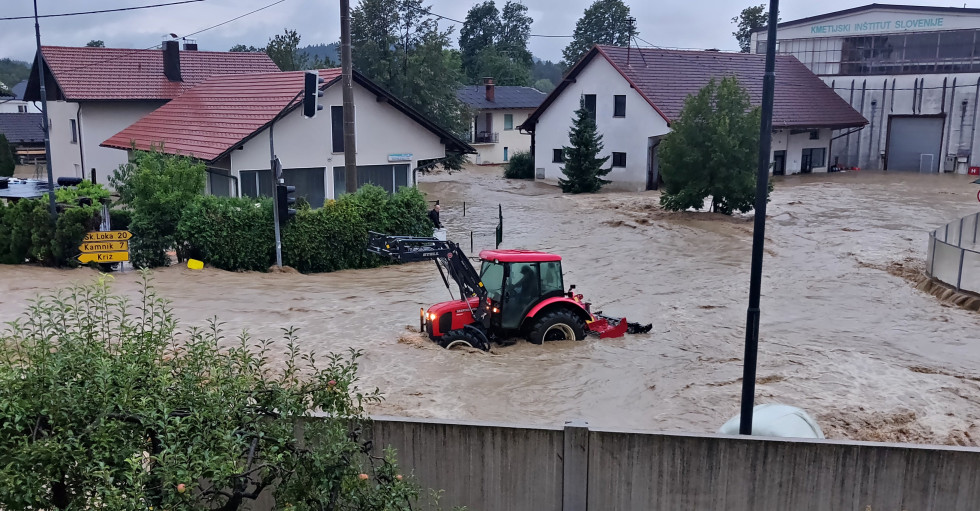The 2023 floods were not just a natural disaster, they were a turning point
- Office of the Government of the Republic of Slovenia for Post-Flood and Landslide Reconstruction
- Government of the Republic of Slovenia
A total of 15,517 affected locations were recorded, with just under 2,000 km of roads and 4,000 km of waterways damaged, several bridges destroyed and dozens more damaged to varying degrees. More than 13,000 buildings were damaged, of which almost 9,000 housing units and residential buildings. Although this is only a fraction of the damage data, it speaks volumes about the exceptional scale of this natural disaster. The events exposed certain shortcomings in spatial and infrastructure management, but at the same time led to demonstrations of exceptional solidarity among people.
Extreme rainfall, which triggered floods and landslides, is directly linked to climate change. Increasingly frequent extreme weather events are becoming a new reality for which we as a society must be systematically prepared. The floods showed that previous investments in water infrastructure are insufficient and that maintenance is often neglected. Many buildings were constructed in flood-prone areas, often contrary to expert advice, which significantly increased damage and endangered human lives. The exceptional willingness to help shown by the people, volunteers, firefighters and organisations, as well as the rapid response of the Government of the Republic of Slovenia, mitigated the consequences of the disaster.
The country's first priority was to take swift action to ensure people's safety, access to basic services and the start of reconstruction. Immediately after the disaster, emergency measures were taken to enable rapid restoration of the affected areas.
The state provided extensive financial assistance to affected individuals, businesses and municipalities: 7,350 beneficiaries received a total of EUR 35.7 million in advance payments for urgent housing renovations, EUR 58,2 million in extraordinary social assistance benefits, EUR 10 million for the rapid supply of basic necessities, distributed among beneficiaries by the Slovenian Red Cross and Caritas Slovenia, EUR 142,1 million in aid for the economy, EUR 4,8 million for the renovation of agricultural buildings, EUR 17,1 million for the renovation of forest roads, EUR 138 million for road infrastructure, EUR 172 million for emergency and extraordinary measures on watercourses, EUR 218.5 million in advance payments to 115 municipalities for urgent repair of municipal infrastructure, EUR 41.3 million for municipal infrastructure rehabilitation and EUR 8.9 million for railway infrastructure.
A total of 190 road closures were recorded as a result of the flooding. Thanks to immediate intervention, connections were quickly established between people in the affected areas. All 1,984 kilometres of roads damaged by the disaster – which is almost a third of all national roads – have been restored to their original condition. By investing in infrastructure upgrades, the government aims to make Slovenia’s infrastructure more resilient to climate change.
By June 2024, all intervention and emergency measures carried out on 850 km of watercourses were completed, with over 1,000 machines and 1,500 workers involved every day. Work on watercourses is carried out as maintenance work, remediation work and investments. The scope of work and resources increased more than tenfold after the floods on 4 August 2023. For the repair of water infrastructure, more than 430 worksites on watercourses were completed in 2024 and by summer 2025, and remediation work is currently underway at more than 300 locations across Slovenia.
An important step forward is the five-year recovery programme, through which the government has allocated EUR 2.3 billion for comprehensive reconstruction – the largest share, EUR 1.3 billion, is earmarked for the repair of watercourses, EUR 800 million will be allocated to the restoration of municipal infrastructure, and EUR 200 million to other measures that will contribute to greater climate resilience.
In the most affected municipalities, recovery remains a challenge, but work on watercourses, landslides and infrastructure continues at a very intense pace. The road to complete recovery is not quick, but our determination is strong. The 2023 floods were not just a natural disaster, they were a turning point. They are an opportunity for Slovenia to build a more resilient, sustainable and connected system that will be able to meet the challenges of the future. The Government of the Republic of Slovenia guarantees that it will not forget the affected people and places – it will continue with key reconstruction projects until the areas are finally stabilised.
The consequences of this major natural disaster can be overcome within the set deadline through continued joint efforts by all – state institutions, local communities, businesses and every individual affected by this greatest natural disaster. Only through joint efforts and mutual understanding can the desired result be achieved through optimal measures – effective remediation and increased resilience within the set five-year timeframe.


